Critical Analysis: The Immorality of Zoos, Animal Captivity & Ethics
VerifiedAdded on 2023/06/13
|6
|1711
|181
Essay
AI Summary
This essay critically examines the ethical implications of zoos, focusing on the immorality of animal captivity and its effects on the value of animal lives. It discusses how zoos, while contributing to tourism and providing recreation, often prioritize human entertainment at the expense of animal welfare. The essay highlights incidents of animal deaths in captivity, raising concerns about security and protection. It argues that contemporary zoos restrict animals' liberty and natural behaviors, causing environmental and habitat changes that can be detrimental. While acknowledging zoos' contributions to scientific monitoring and disease control, the essay concludes that depriving animals of their natural habitats for human entertainment is unethical and that society should reconsider the purpose and operation of zoos, suggesting alternatives like wildlife documentaries to educate the public.
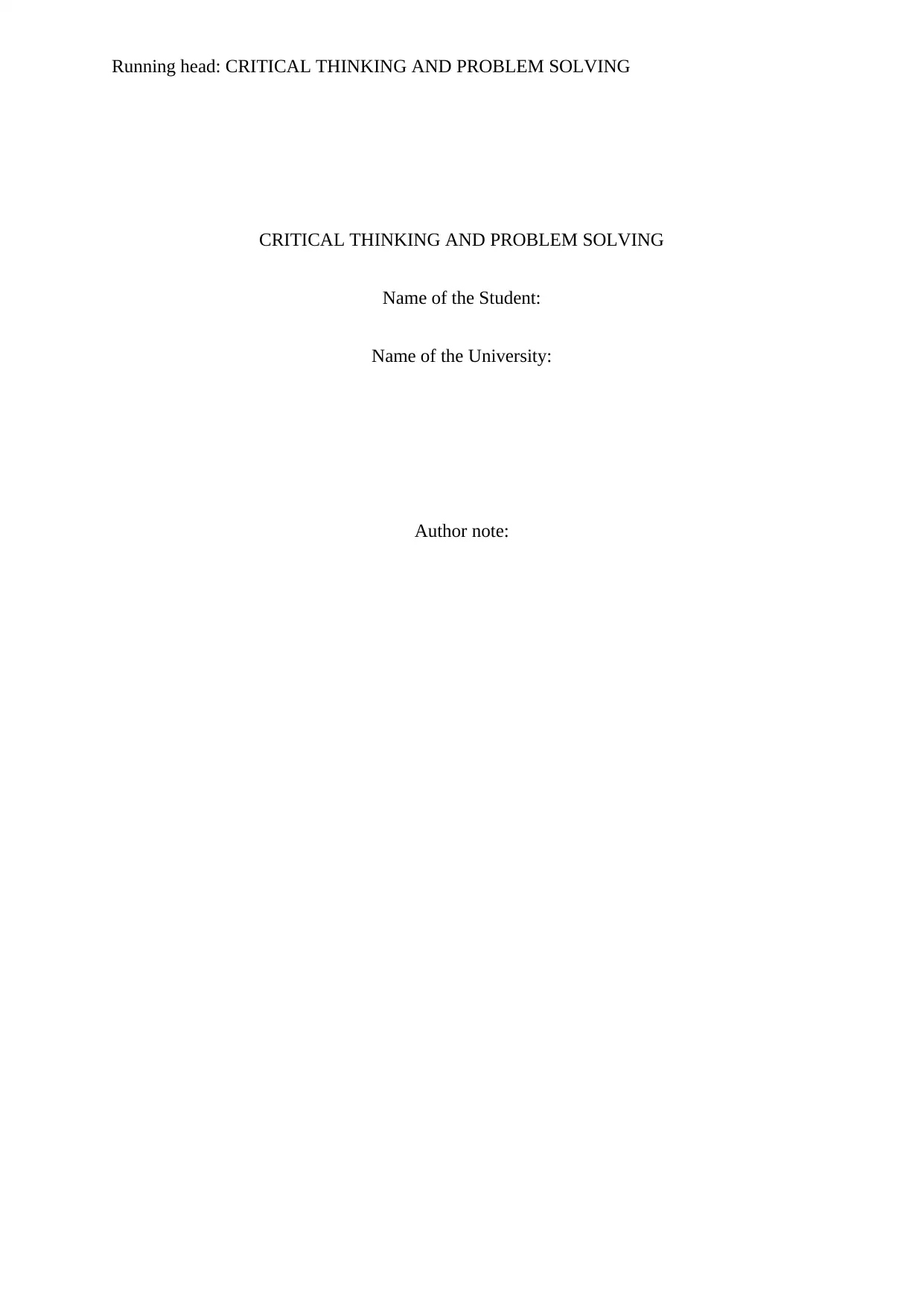
Running head: CRITICAL THINKING AND PROBLEM SOLVING
CRITICAL THINKING AND PROBLEM SOLVING
Name of the Student:
Name of the University:
Author note:
CRITICAL THINKING AND PROBLEM SOLVING
Name of the Student:
Name of the University:
Author note:
Paraphrase This Document
Need a fresh take? Get an instant paraphrase of this document with our AI Paraphraser
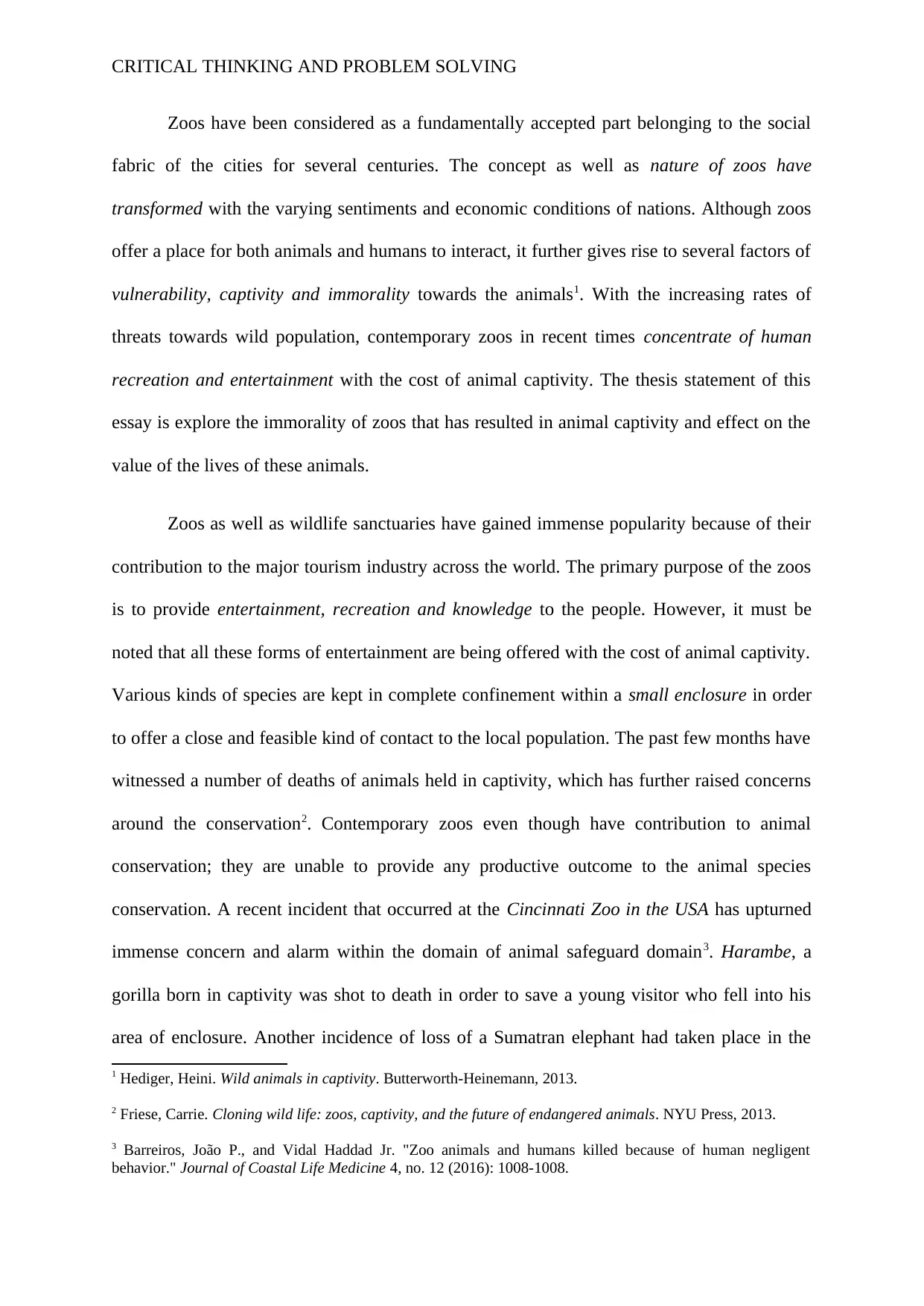
CRITICAL THINKING AND PROBLEM SOLVING
Zoos have been considered as a fundamentally accepted part belonging to the social
fabric of the cities for several centuries. The concept as well as nature of zoos have
transformed with the varying sentiments and economic conditions of nations. Although zoos
offer a place for both animals and humans to interact, it further gives rise to several factors of
vulnerability, captivity and immorality towards the animals1. With the increasing rates of
threats towards wild population, contemporary zoos in recent times concentrate of human
recreation and entertainment with the cost of animal captivity. The thesis statement of this
essay is explore the immorality of zoos that has resulted in animal captivity and effect on the
value of the lives of these animals.
Zoos as well as wildlife sanctuaries have gained immense popularity because of their
contribution to the major tourism industry across the world. The primary purpose of the zoos
is to provide entertainment, recreation and knowledge to the people. However, it must be
noted that all these forms of entertainment are being offered with the cost of animal captivity.
Various kinds of species are kept in complete confinement within a small enclosure in order
to offer a close and feasible kind of contact to the local population. The past few months have
witnessed a number of deaths of animals held in captivity, which has further raised concerns
around the conservation2. Contemporary zoos even though have contribution to animal
conservation; they are unable to provide any productive outcome to the animal species
conservation. A recent incident that occurred at the Cincinnati Zoo in the USA has upturned
immense concern and alarm within the domain of animal safeguard domain3. Harambe, a
gorilla born in captivity was shot to death in order to save a young visitor who fell into his
area of enclosure. Another incidence of loss of a Sumatran elephant had taken place in the
1 Hediger, Heini. Wild animals in captivity. Butterworth-Heinemann, 2013.
2 Friese, Carrie. Cloning wild life: zoos, captivity, and the future of endangered animals. NYU Press, 2013.
3 Barreiros, João P., and Vidal Haddad Jr. "Zoo animals and humans killed because of human negligent
behavior." Journal of Coastal Life Medicine 4, no. 12 (2016): 1008-1008.
Zoos have been considered as a fundamentally accepted part belonging to the social
fabric of the cities for several centuries. The concept as well as nature of zoos have
transformed with the varying sentiments and economic conditions of nations. Although zoos
offer a place for both animals and humans to interact, it further gives rise to several factors of
vulnerability, captivity and immorality towards the animals1. With the increasing rates of
threats towards wild population, contemporary zoos in recent times concentrate of human
recreation and entertainment with the cost of animal captivity. The thesis statement of this
essay is explore the immorality of zoos that has resulted in animal captivity and effect on the
value of the lives of these animals.
Zoos as well as wildlife sanctuaries have gained immense popularity because of their
contribution to the major tourism industry across the world. The primary purpose of the zoos
is to provide entertainment, recreation and knowledge to the people. However, it must be
noted that all these forms of entertainment are being offered with the cost of animal captivity.
Various kinds of species are kept in complete confinement within a small enclosure in order
to offer a close and feasible kind of contact to the local population. The past few months have
witnessed a number of deaths of animals held in captivity, which has further raised concerns
around the conservation2. Contemporary zoos even though have contribution to animal
conservation; they are unable to provide any productive outcome to the animal species
conservation. A recent incident that occurred at the Cincinnati Zoo in the USA has upturned
immense concern and alarm within the domain of animal safeguard domain3. Harambe, a
gorilla born in captivity was shot to death in order to save a young visitor who fell into his
area of enclosure. Another incidence of loss of a Sumatran elephant had taken place in the
1 Hediger, Heini. Wild animals in captivity. Butterworth-Heinemann, 2013.
2 Friese, Carrie. Cloning wild life: zoos, captivity, and the future of endangered animals. NYU Press, 2013.
3 Barreiros, João P., and Vidal Haddad Jr. "Zoo animals and humans killed because of human negligent
behavior." Journal of Coastal Life Medicine 4, no. 12 (2016): 1008-1008.
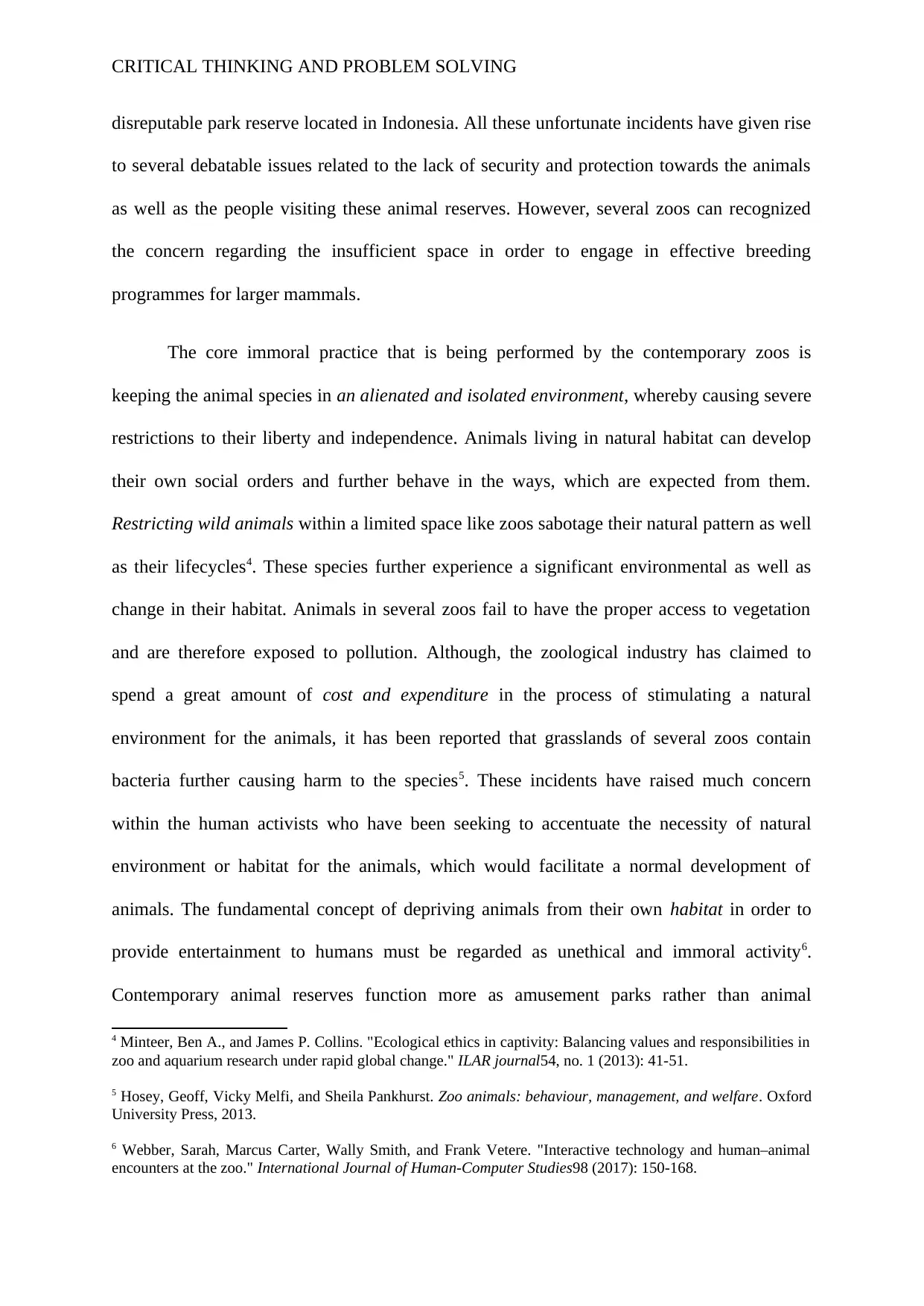
CRITICAL THINKING AND PROBLEM SOLVING
disreputable park reserve located in Indonesia. All these unfortunate incidents have given rise
to several debatable issues related to the lack of security and protection towards the animals
as well as the people visiting these animal reserves. However, several zoos can recognized
the concern regarding the insufficient space in order to engage in effective breeding
programmes for larger mammals.
The core immoral practice that is being performed by the contemporary zoos is
keeping the animal species in an alienated and isolated environment, whereby causing severe
restrictions to their liberty and independence. Animals living in natural habitat can develop
their own social orders and further behave in the ways, which are expected from them.
Restricting wild animals within a limited space like zoos sabotage their natural pattern as well
as their lifecycles4. These species further experience a significant environmental as well as
change in their habitat. Animals in several zoos fail to have the proper access to vegetation
and are therefore exposed to pollution. Although, the zoological industry has claimed to
spend a great amount of cost and expenditure in the process of stimulating a natural
environment for the animals, it has been reported that grasslands of several zoos contain
bacteria further causing harm to the species5. These incidents have raised much concern
within the human activists who have been seeking to accentuate the necessity of natural
environment or habitat for the animals, which would facilitate a normal development of
animals. The fundamental concept of depriving animals from their own habitat in order to
provide entertainment to humans must be regarded as unethical and immoral activity6.
Contemporary animal reserves function more as amusement parks rather than animal
4 Minteer, Ben A., and James P. Collins. "Ecological ethics in captivity: Balancing values and responsibilities in
zoo and aquarium research under rapid global change." ILAR journal54, no. 1 (2013): 41-51.
5 Hosey, Geoff, Vicky Melfi, and Sheila Pankhurst. Zoo animals: behaviour, management, and welfare. Oxford
University Press, 2013.
6 Webber, Sarah, Marcus Carter, Wally Smith, and Frank Vetere. "Interactive technology and human–animal
encounters at the zoo." International Journal of Human-Computer Studies98 (2017): 150-168.
disreputable park reserve located in Indonesia. All these unfortunate incidents have given rise
to several debatable issues related to the lack of security and protection towards the animals
as well as the people visiting these animal reserves. However, several zoos can recognized
the concern regarding the insufficient space in order to engage in effective breeding
programmes for larger mammals.
The core immoral practice that is being performed by the contemporary zoos is
keeping the animal species in an alienated and isolated environment, whereby causing severe
restrictions to their liberty and independence. Animals living in natural habitat can develop
their own social orders and further behave in the ways, which are expected from them.
Restricting wild animals within a limited space like zoos sabotage their natural pattern as well
as their lifecycles4. These species further experience a significant environmental as well as
change in their habitat. Animals in several zoos fail to have the proper access to vegetation
and are therefore exposed to pollution. Although, the zoological industry has claimed to
spend a great amount of cost and expenditure in the process of stimulating a natural
environment for the animals, it has been reported that grasslands of several zoos contain
bacteria further causing harm to the species5. These incidents have raised much concern
within the human activists who have been seeking to accentuate the necessity of natural
environment or habitat for the animals, which would facilitate a normal development of
animals. The fundamental concept of depriving animals from their own habitat in order to
provide entertainment to humans must be regarded as unethical and immoral activity6.
Contemporary animal reserves function more as amusement parks rather than animal
4 Minteer, Ben A., and James P. Collins. "Ecological ethics in captivity: Balancing values and responsibilities in
zoo and aquarium research under rapid global change." ILAR journal54, no. 1 (2013): 41-51.
5 Hosey, Geoff, Vicky Melfi, and Sheila Pankhurst. Zoo animals: behaviour, management, and welfare. Oxford
University Press, 2013.
6 Webber, Sarah, Marcus Carter, Wally Smith, and Frank Vetere. "Interactive technology and human–animal
encounters at the zoo." International Journal of Human-Computer Studies98 (2017): 150-168.
⊘ This is a preview!⊘
Do you want full access?
Subscribe today to unlock all pages.

Trusted by 1+ million students worldwide
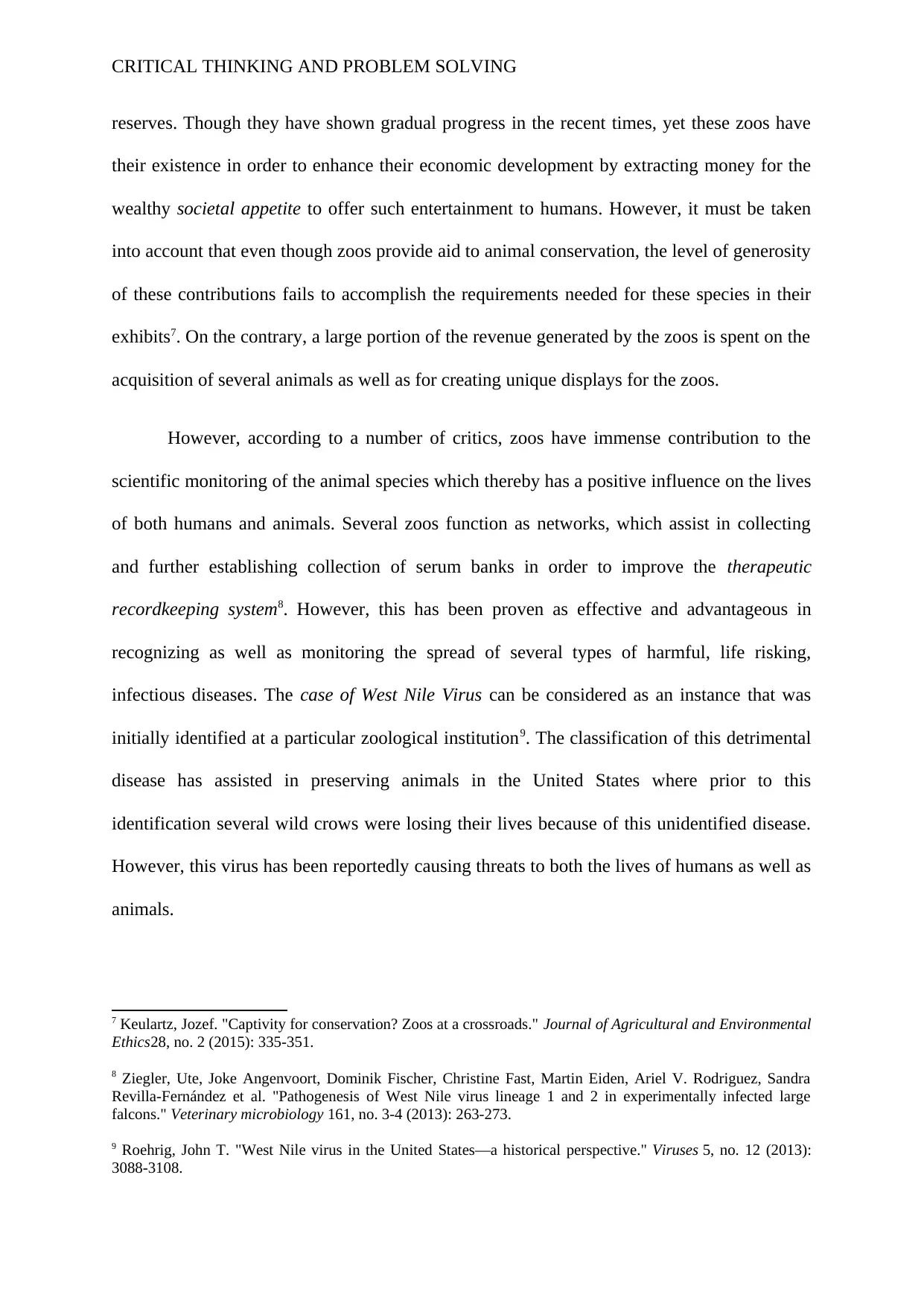
CRITICAL THINKING AND PROBLEM SOLVING
reserves. Though they have shown gradual progress in the recent times, yet these zoos have
their existence in order to enhance their economic development by extracting money for the
wealthy societal appetite to offer such entertainment to humans. However, it must be taken
into account that even though zoos provide aid to animal conservation, the level of generosity
of these contributions fails to accomplish the requirements needed for these species in their
exhibits7. On the contrary, a large portion of the revenue generated by the zoos is spent on the
acquisition of several animals as well as for creating unique displays for the zoos.
However, according to a number of critics, zoos have immense contribution to the
scientific monitoring of the animal species which thereby has a positive influence on the lives
of both humans and animals. Several zoos function as networks, which assist in collecting
and further establishing collection of serum banks in order to improve the therapeutic
recordkeeping system8. However, this has been proven as effective and advantageous in
recognizing as well as monitoring the spread of several types of harmful, life risking,
infectious diseases. The case of West Nile Virus can be considered as an instance that was
initially identified at a particular zoological institution9. The classification of this detrimental
disease has assisted in preserving animals in the United States where prior to this
identification several wild crows were losing their lives because of this unidentified disease.
However, this virus has been reportedly causing threats to both the lives of humans as well as
animals.
7 Keulartz, Jozef. "Captivity for conservation? Zoos at a crossroads." Journal of Agricultural and Environmental
Ethics28, no. 2 (2015): 335-351.
8 Ziegler, Ute, Joke Angenvoort, Dominik Fischer, Christine Fast, Martin Eiden, Ariel V. Rodriguez, Sandra
Revilla-Fernández et al. "Pathogenesis of West Nile virus lineage 1 and 2 in experimentally infected large
falcons." Veterinary microbiology 161, no. 3-4 (2013): 263-273.
9 Roehrig, John T. "West Nile virus in the United States—a historical perspective." Viruses 5, no. 12 (2013):
3088-3108.
reserves. Though they have shown gradual progress in the recent times, yet these zoos have
their existence in order to enhance their economic development by extracting money for the
wealthy societal appetite to offer such entertainment to humans. However, it must be taken
into account that even though zoos provide aid to animal conservation, the level of generosity
of these contributions fails to accomplish the requirements needed for these species in their
exhibits7. On the contrary, a large portion of the revenue generated by the zoos is spent on the
acquisition of several animals as well as for creating unique displays for the zoos.
However, according to a number of critics, zoos have immense contribution to the
scientific monitoring of the animal species which thereby has a positive influence on the lives
of both humans and animals. Several zoos function as networks, which assist in collecting
and further establishing collection of serum banks in order to improve the therapeutic
recordkeeping system8. However, this has been proven as effective and advantageous in
recognizing as well as monitoring the spread of several types of harmful, life risking,
infectious diseases. The case of West Nile Virus can be considered as an instance that was
initially identified at a particular zoological institution9. The classification of this detrimental
disease has assisted in preserving animals in the United States where prior to this
identification several wild crows were losing their lives because of this unidentified disease.
However, this virus has been reportedly causing threats to both the lives of humans as well as
animals.
7 Keulartz, Jozef. "Captivity for conservation? Zoos at a crossroads." Journal of Agricultural and Environmental
Ethics28, no. 2 (2015): 335-351.
8 Ziegler, Ute, Joke Angenvoort, Dominik Fischer, Christine Fast, Martin Eiden, Ariel V. Rodriguez, Sandra
Revilla-Fernández et al. "Pathogenesis of West Nile virus lineage 1 and 2 in experimentally infected large
falcons." Veterinary microbiology 161, no. 3-4 (2013): 263-273.
9 Roehrig, John T. "West Nile virus in the United States—a historical perspective." Viruses 5, no. 12 (2013):
3088-3108.
Paraphrase This Document
Need a fresh take? Get an instant paraphrase of this document with our AI Paraphraser
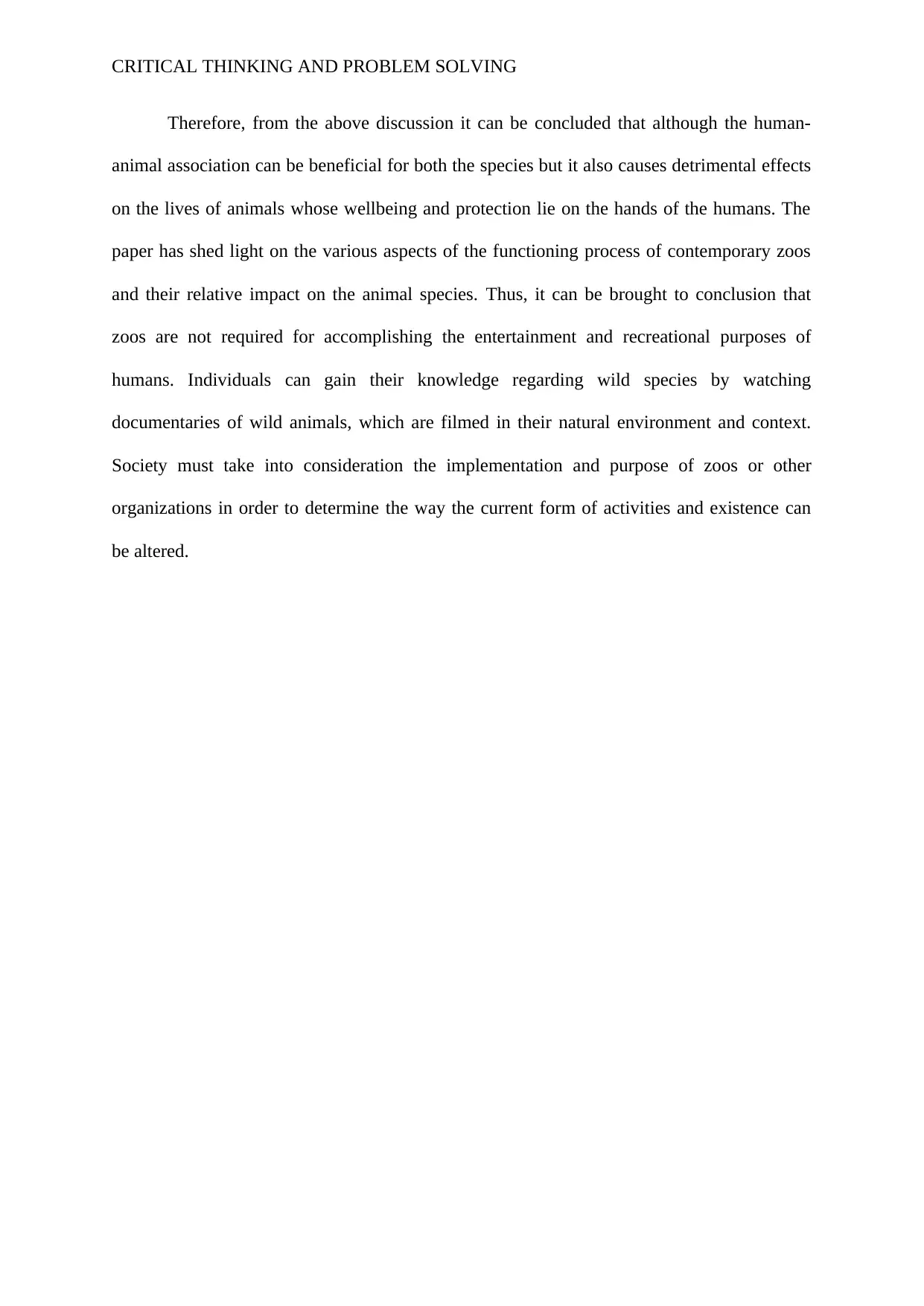
CRITICAL THINKING AND PROBLEM SOLVING
Therefore, from the above discussion it can be concluded that although the human-
animal association can be beneficial for both the species but it also causes detrimental effects
on the lives of animals whose wellbeing and protection lie on the hands of the humans. The
paper has shed light on the various aspects of the functioning process of contemporary zoos
and their relative impact on the animal species. Thus, it can be brought to conclusion that
zoos are not required for accomplishing the entertainment and recreational purposes of
humans. Individuals can gain their knowledge regarding wild species by watching
documentaries of wild animals, which are filmed in their natural environment and context.
Society must take into consideration the implementation and purpose of zoos or other
organizations in order to determine the way the current form of activities and existence can
be altered.
Therefore, from the above discussion it can be concluded that although the human-
animal association can be beneficial for both the species but it also causes detrimental effects
on the lives of animals whose wellbeing and protection lie on the hands of the humans. The
paper has shed light on the various aspects of the functioning process of contemporary zoos
and their relative impact on the animal species. Thus, it can be brought to conclusion that
zoos are not required for accomplishing the entertainment and recreational purposes of
humans. Individuals can gain their knowledge regarding wild species by watching
documentaries of wild animals, which are filmed in their natural environment and context.
Society must take into consideration the implementation and purpose of zoos or other
organizations in order to determine the way the current form of activities and existence can
be altered.
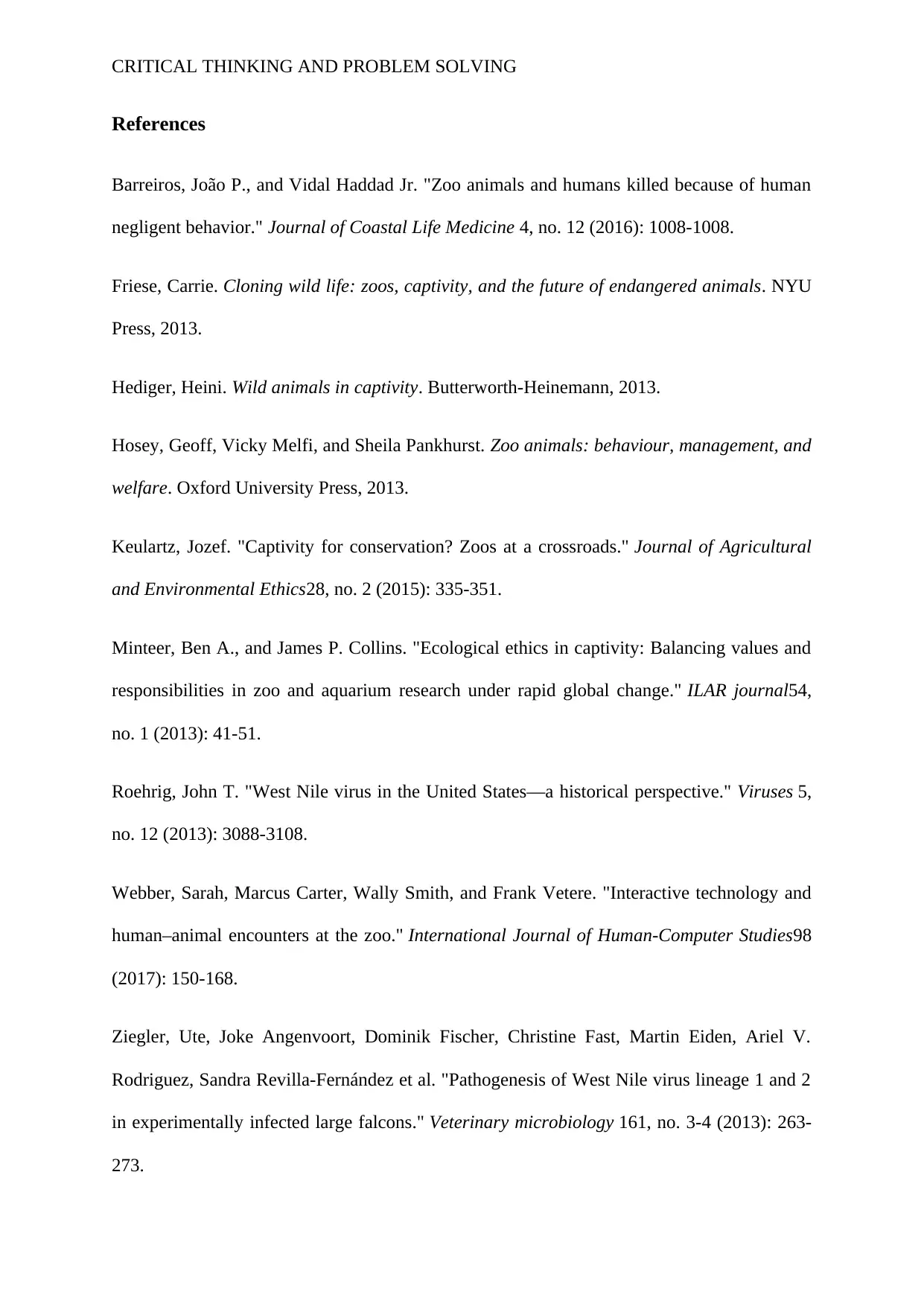
CRITICAL THINKING AND PROBLEM SOLVING
References
Barreiros, João P., and Vidal Haddad Jr. "Zoo animals and humans killed because of human
negligent behavior." Journal of Coastal Life Medicine 4, no. 12 (2016): 1008-1008.
Friese, Carrie. Cloning wild life: zoos, captivity, and the future of endangered animals. NYU
Press, 2013.
Hediger, Heini. Wild animals in captivity. Butterworth-Heinemann, 2013.
Hosey, Geoff, Vicky Melfi, and Sheila Pankhurst. Zoo animals: behaviour, management, and
welfare. Oxford University Press, 2013.
Keulartz, Jozef. "Captivity for conservation? Zoos at a crossroads." Journal of Agricultural
and Environmental Ethics28, no. 2 (2015): 335-351.
Minteer, Ben A., and James P. Collins. "Ecological ethics in captivity: Balancing values and
responsibilities in zoo and aquarium research under rapid global change." ILAR journal54,
no. 1 (2013): 41-51.
Roehrig, John T. "West Nile virus in the United States—a historical perspective." Viruses 5,
no. 12 (2013): 3088-3108.
Webber, Sarah, Marcus Carter, Wally Smith, and Frank Vetere. "Interactive technology and
human–animal encounters at the zoo." International Journal of Human-Computer Studies98
(2017): 150-168.
Ziegler, Ute, Joke Angenvoort, Dominik Fischer, Christine Fast, Martin Eiden, Ariel V.
Rodriguez, Sandra Revilla-Fernández et al. "Pathogenesis of West Nile virus lineage 1 and 2
in experimentally infected large falcons." Veterinary microbiology 161, no. 3-4 (2013): 263-
273.
References
Barreiros, João P., and Vidal Haddad Jr. "Zoo animals and humans killed because of human
negligent behavior." Journal of Coastal Life Medicine 4, no. 12 (2016): 1008-1008.
Friese, Carrie. Cloning wild life: zoos, captivity, and the future of endangered animals. NYU
Press, 2013.
Hediger, Heini. Wild animals in captivity. Butterworth-Heinemann, 2013.
Hosey, Geoff, Vicky Melfi, and Sheila Pankhurst. Zoo animals: behaviour, management, and
welfare. Oxford University Press, 2013.
Keulartz, Jozef. "Captivity for conservation? Zoos at a crossroads." Journal of Agricultural
and Environmental Ethics28, no. 2 (2015): 335-351.
Minteer, Ben A., and James P. Collins. "Ecological ethics in captivity: Balancing values and
responsibilities in zoo and aquarium research under rapid global change." ILAR journal54,
no. 1 (2013): 41-51.
Roehrig, John T. "West Nile virus in the United States—a historical perspective." Viruses 5,
no. 12 (2013): 3088-3108.
Webber, Sarah, Marcus Carter, Wally Smith, and Frank Vetere. "Interactive technology and
human–animal encounters at the zoo." International Journal of Human-Computer Studies98
(2017): 150-168.
Ziegler, Ute, Joke Angenvoort, Dominik Fischer, Christine Fast, Martin Eiden, Ariel V.
Rodriguez, Sandra Revilla-Fernández et al. "Pathogenesis of West Nile virus lineage 1 and 2
in experimentally infected large falcons." Veterinary microbiology 161, no. 3-4 (2013): 263-
273.
⊘ This is a preview!⊘
Do you want full access?
Subscribe today to unlock all pages.

Trusted by 1+ million students worldwide
1 out of 6
Your All-in-One AI-Powered Toolkit for Academic Success.
+13062052269
info@desklib.com
Available 24*7 on WhatsApp / Email
![[object Object]](/_next/static/media/star-bottom.7253800d.svg)
Unlock your academic potential
Copyright © 2020–2025 A2Z Services. All Rights Reserved. Developed and managed by ZUCOL.